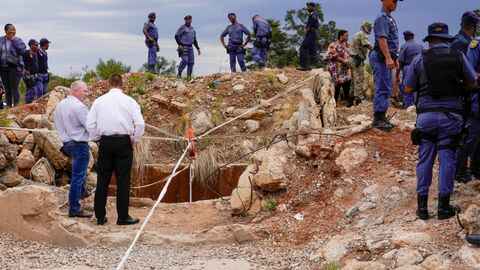After launching a new rescue effort, authorities said they are still confirming reports on the number of bodies discovered and the number of survivors hauled out.
According to an organization that represents the miners, at least 100 men who were engaged in illicit mining in an abandoned South African gold mine have perished from what is believed to be malnutrition and dehydration after being confined underground for months while police attempted to extricate them.
The group reported Monday that more than 500 people are still stranded.
A representative for the Mining Affected Communities United in Action Group, Sabelo Mnguni, told The Associated Press that two films of dozens of plastic-wrapped dead underground were found on a cellphone that was sent to the surface on Friday with several rescued miners.
In the North West province mine, where police initially began an operation in November to drive the miners out, Mnguni said “a minimum” of 100 men had perished.
According to Mnguni, they were thought to have either died from starvation or dehydration. Since Friday, he claimed, eighteen bodies have been brought out.
He said a community-led operation on Friday recovered nine of the bodies. In an official rescue operation on Monday, authorities hauled out 26 individuals and recovered nine more, according to Mnguni.
After beginning a new rescue effort on Monday, police spokesperson Brigadier Sebata Mokgwabone stated that they were still confirming reports on the number of bodies discovered and the number of survivors brought out.
According to authorities, they now intend to bring out every miner.
Miners and police are at odds.
In some areas of gold-rich South Africa, illicit mining is widespread. When businesses wind down unprofitable mines, gangs of informal miners access the site unlawfully in an attempt to locate any remaining reserves.
Since authorities first tried to extract the miners and close the mine two months ago, there has been a confrontation between police and miners at the mine in question, which is located southwest of Johannesburg near the town of Stilfontein.
Mnguni claimed that after police took away the ropes they used to enter and exit the Buffelsfontein Gold Mine, the miners were trapped underground and refused to leave out of fear of being arrested.
In an effort to evict the miners, police also cut off their food supplies; Mnguni’s organization, MACUA, and others strongly condemned this move. In December, MACUA prevailed in a court lawsuit that mandated that provincial and police officials permit the miners to receive food, drink, and medication.
When the South African government declined to assist the miners last year, it also came under fire.
The smartphone recordings, which were made public by Mnguni’s group and are allegedly from the mine’s depths, show dozens of what look to be plastic-wrapped dead bodies laying in dimly lit passageways. One of the films shows a man filming on his phone, stating, “This is hunger.” He documents emaciated-looking males sitting on the mine’s moist floor, saying, “People are dying because of hunger.”
“Please help us,” he continues. Take us out or bring us some food.”
At 2.5 kilometers deep, the mine is one of the deepest in South Africa, with numerous shafts, levels, and a labyrinth of tunnels. Mnguni stated that the more than 500 miners who were still down were spread out around the mine.
According to him, a preliminary autopsy report on a body that had earlier been removed from the mine revealed that the individual had starved to death.
“What we understand is that there are different groups of miners underground, and all of them have miners who have died,” Mnguni stated.
“So, we are estimating that the number of those who have died is very high.”
In order to maximize their earnings, large groups of illegal miners frequently spend months below. They bring food, water, generators, and other equipment with them, but they also rely on other members of their organization on the surface to send down additional supplies.






